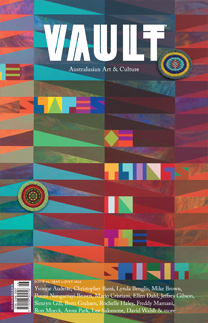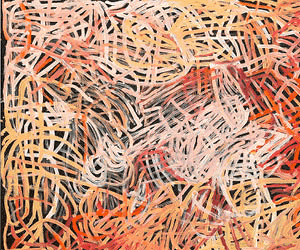AI: Artificial Imagination – No Threat to Serwah Attafuah
Identified as the new frontier of the 21st century, artificial intelligence has seeped into the everyday, including in the art world. VAULT discusses the phenomenon with digital art star Serwah Attafuah and curator Gillian Kayrooz.
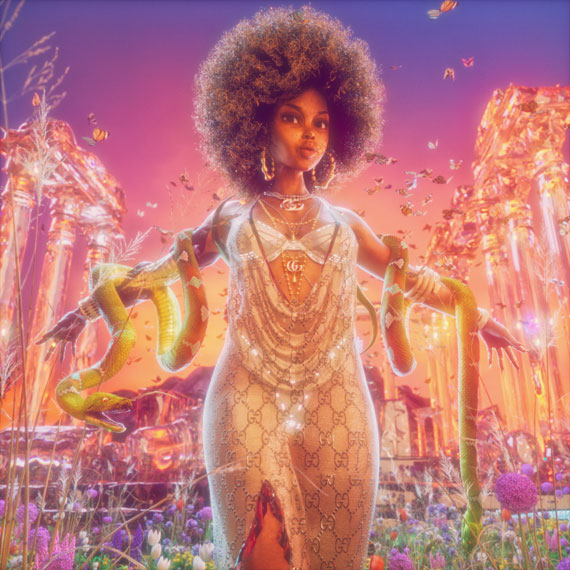
Image credit: Serwah Attafuah, UT SUPRA, UT INFRA (As Above, So Below), 2023, Animated digital 3D render, 1920 x 1920 px, commissioned by Powerhouse, 2022. Courtesy the artist
Whether creating digital work for a gallery exhibition or a private collector, Serwah Attafuah deliberately keeps her process ambiguous. “One of the things I love most about sharing my work is hearing how it impacts other people.”
Western Sydney-based Attafuah (b. 1998) has been tagged by InStyle magazine as an NFT (non-fungible token) ‘Artist for Tomorrow’. In the last few years she has collaborated with and been commissioned by the likes of Mercedes-Benz, Nike, Valentino and Paris Hilton, and participated in the landmark Sotheby’s Natively Digital: A Curated NFT Sale (2021).
The notion of artists embracing AI does not faze Australian-born, Pulitzer Prize-winning art critic Sebastian Smee. “Instead of thinking of AI generated art as a doomsday development – a cluster bomb thrown by big tech into the heart of the art world – you can think of it as something with its own fascinating history, intoxicating present and unknown future. Something to be curious about.”
In 2022, the Powerhouse Museum in Sydney hosted Gucci Garden Archetypes, an immersive multi-sensory exhibition that was both a celebration of Italian fashion house Gucci’s 100th anniversary and a swansong for its visionary creative director, Alessandro Michele, after seven years at the helm. What could have been perceived as a lavish marketing extravaganza was transformed into a cinematic art installation, paying tribute to cutting-edge technology, intricate hand-crafting and innovative interior design.
Understood as Michele’s personal creative manifesto, Gucci Garden Archetypes sampled a broad cultural swathe, from Greek mythology to the Palace of Versailles’ mirror labyrinth, and the May 1968 student-led uprising in Paris to a 1980s Berlin nightclub. The central theme underpinning the exhibition: imagination is a force that has no limitations.
Embracing Michele’s campaign to use art to reach audiences of all ages and demographics, the Powerhouse commissioned five Sydney-based artists — Serwah Attafuah, Jade D’Amico, Amani Haydar, Emma Pham and Justine Youssef — to create digital work responding to Gucci Garden Archetypes. Their final pieces were showcased in the group exhibition Arcadia (2022).
“The brief for Arcadia was pretty open-ended,” says Attafuah. “I took some of my favourite Gucci archetypes – such as the garden, the monogram, snakes and 1970s-era aesthetic – and put them into my world. I wanted to make something that felt mystical, too.”
For curator Gillian Kayrooz, Arcadia was an exciting challenge – to stage an all-digital exhibition without installing everything onto flat screens. “As each of the artists worked with very different mediums – from pixel-art, painting, video and photography through to digital art – the focus was more on how we could support them to each arrive at a digital outcome that could then be installed in the space and speak together as an exhibition.”
Both the Gucci Garden Archetypes and Arcadia exhibitions attracted audiences that had not previously engaged with the museum. “It was particularly interesting to see both exhibitions make it to my TikTok algorithm without prompting,” says Kayrooz. Interesting, too, that only one of the five artists, self-taught Attafuah, was working with AI and experimenting with AI image generators such as Midjourney and Stable Diffusion when the Arcadia digital work was commissioned.
“I’m really grateful to have been surrounded by very talented people in my early life,” says Attafuah. Both her parents are artists, her Ghanaian father a sculptor and her Italian-Dutch mother involved in graphic design. Attafuah left school at age 14 to pursue design, painting and music, and has also delved into dance and film. “Having so many creative outlets has been fantastic because writer’s block almost doesn’t exist for me – I can just move on to another medium. It also helps me to be more experimental.”
Attafuah’s decision to pursue digital art in the early 2010s was due to lack of physical space. “I started creating digital art mainly because my family garage had to be knocked down, [and] that left me without a place to paint,” she explains. “I used to paint every day – I had a real passion for oil painting – so it was a real shock to my system. Digital art made the most sense; it was something I could do anywhere with just a device, and it seemed so full of possibilities.”
She describes her works as surreal cyber dreamscapes and heavenly wastelands. For the Arcadia exhibition, she drew inspiration from Hieronymus Bosch’s The Garden of Earthly Delights and the biblical characters of Lilith and Eve.
“Attafuah’s large-scale single-channel looped image was projected onto a raised square-screen platform,” explains exhibition curator Kayrooz, “showcasing her now extremely recognisable aesthetic, using bold sunset-reminiscent colours and incredibly detailed figures. The work was a coming together of our realm and places beyond in her own metaverse, featuring Gucci iconography.”
The Art Gallery of New South Wales’ recent Volume: Festival of Sound and Vision (2023) featured a Sistine Chapel-inspired projection by Attafuah with characters in Rococo-style sci-fi dress. “I love the classical lighting of the Renaissance era, the maximalism of Rococo and the spirit of Afrofuturism,” she explains. “Most of my artworks feature what I call ‘reflections of self’ – some of the characters are a version of myself, some are abstractions, some are ancestors or people yet to be born into this world.”
Attafuah is not intimidated by technological developments that have enabled AI to produce both concept and final artwork with very limited instruction. “I’m definitely no AI expert, but I love learning more about this technology – I’ve been using it to experiment and play with. For me, it’s super easy to see if something has been created by AI. If you have a style and personal brand that is unique enough, then no AI could replace you as an artist.”
Kayrooz agrees. “The conversation of AI ‘replacing’ feels very real and present in a lot of industries, but it will be difficult to replace the inherent value of an artist’s process, critical thinking and relationship to audiences. The word ‘curator’ originates from the Latin cura, which means ‘to care’, whether that be caring for objects, artworks, artists, relationships or communities. Ultimately, it will be interesting to see if AI will be able to ‘care’ as much as humans do.”
Meanwhile, Attafuah has her eyes set on her next big gig, the 24th Biennale of Sydney. “I’m super-excited,” she says. “This will be my biggest piece in terms of scale and detail yet.”
Save the date.
Serwah Attafuah will show in the 24th Biennale of Sydney from March 9 to June 10, 2024.
biennaleofsydney.art
serwah.xyz

Image credit: Serwah Attafuah, Creation of My Metaverse (Between this World and the Next), 2021, Digital 3D render, 6000 x 8200 px. Courtesy the artist
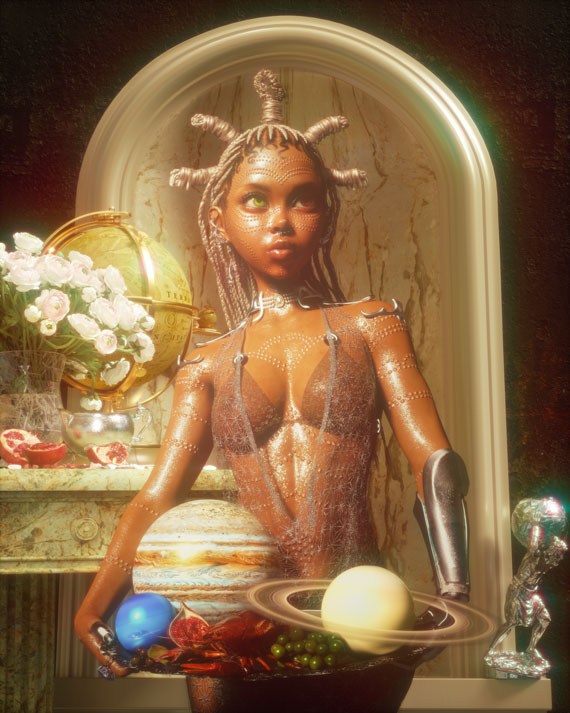
Image credit: Serwah Attafuah, TERRA, 2021, Digital 3D render, 5600 x 7000 px. Courtesy the artist

Image credit: Serwah Attafuah, Untitled (Cinderella), 2020, Digital 3D render, 4000 x 4000 px. Courtesy the artist
This article was originally published in VAULT Magazine Issue 44 (November 2023 – January 2024).
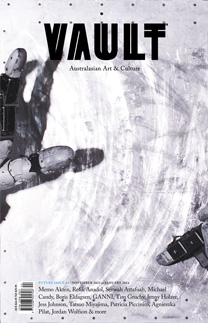
Click here to Subscribe







